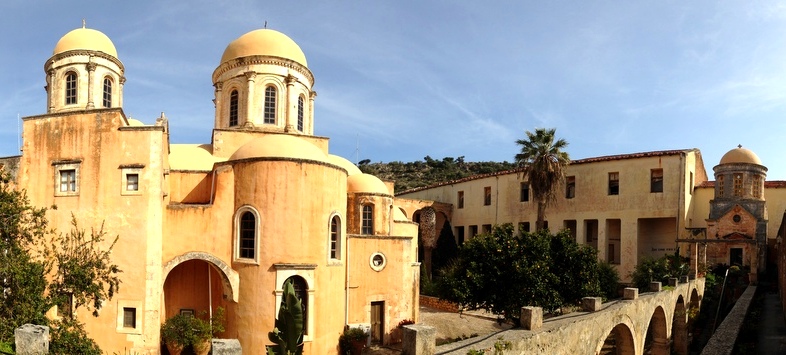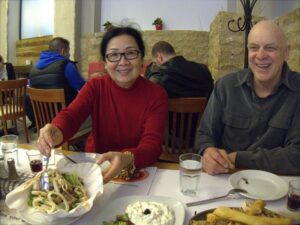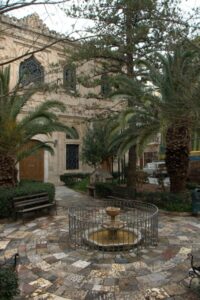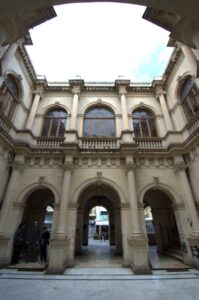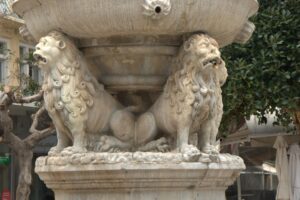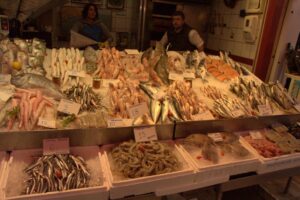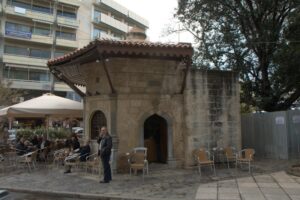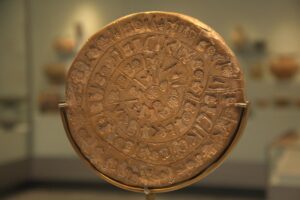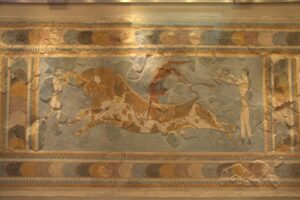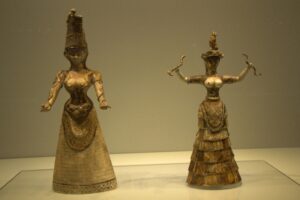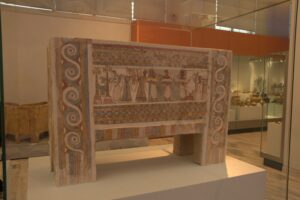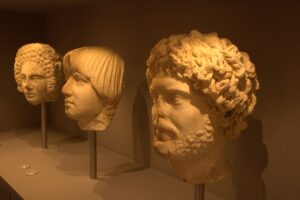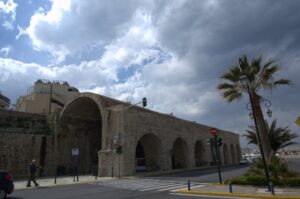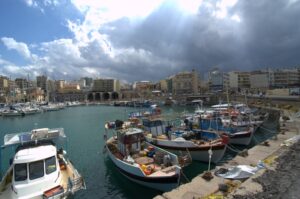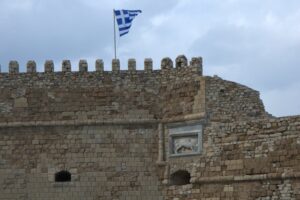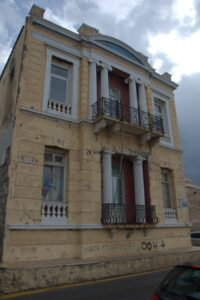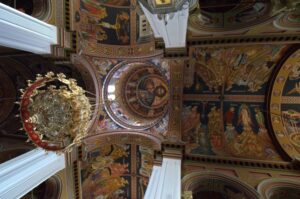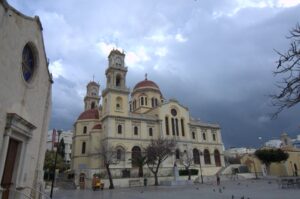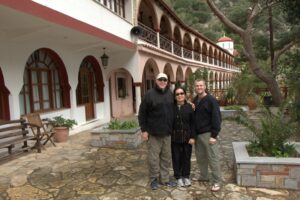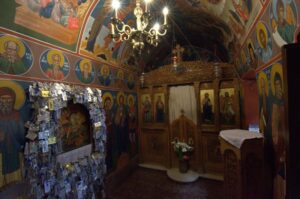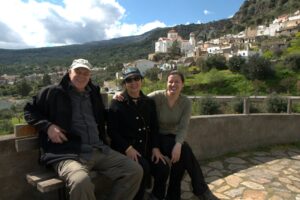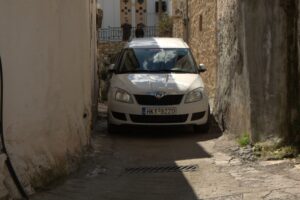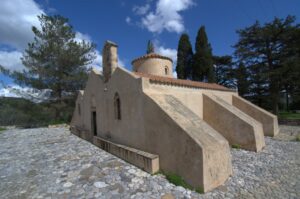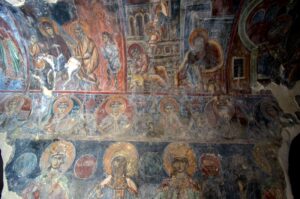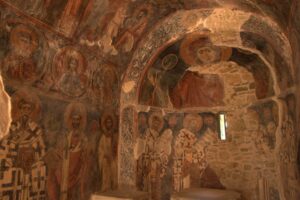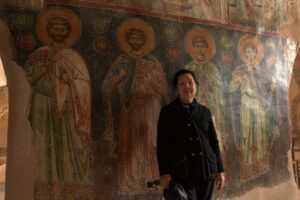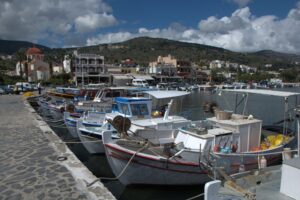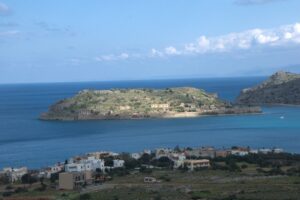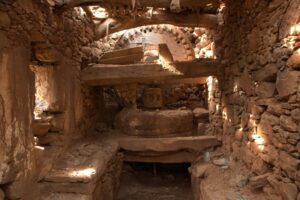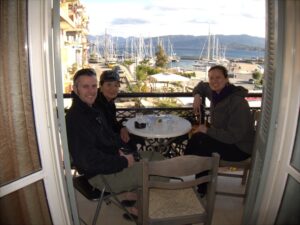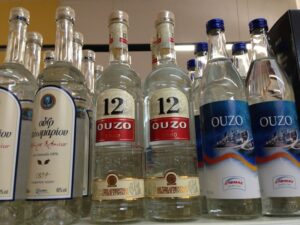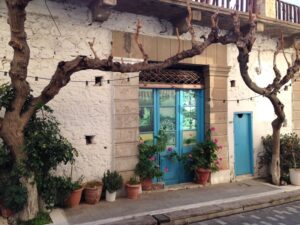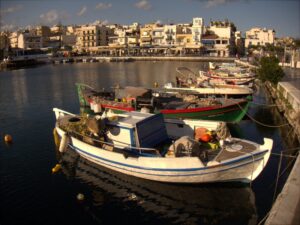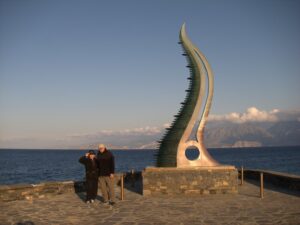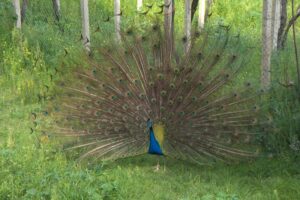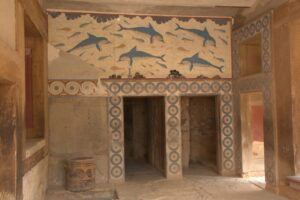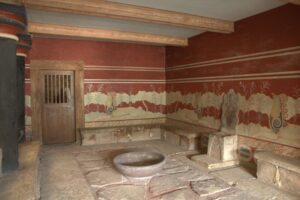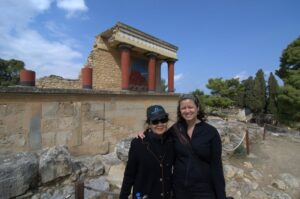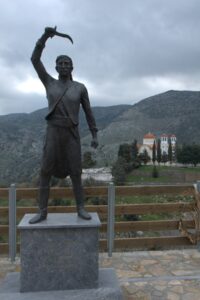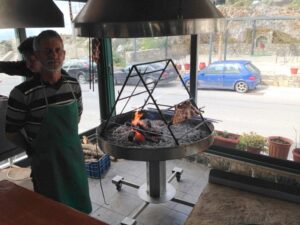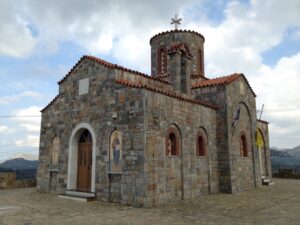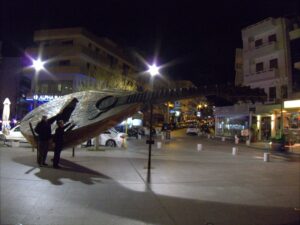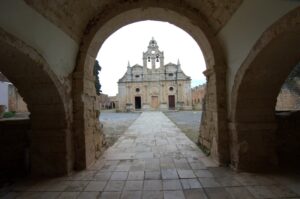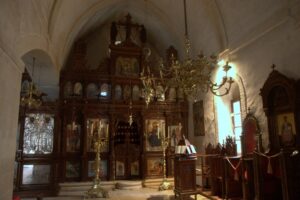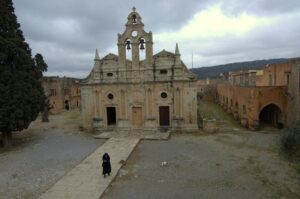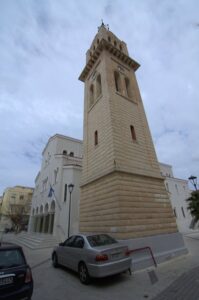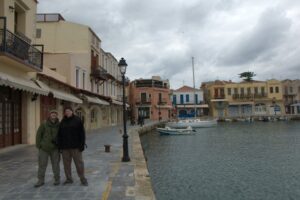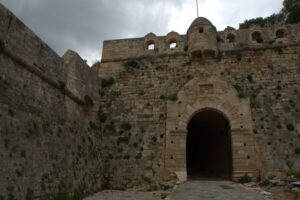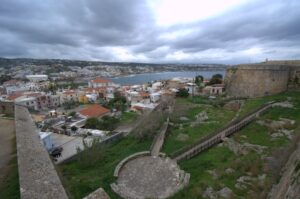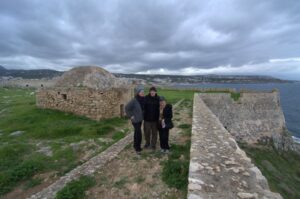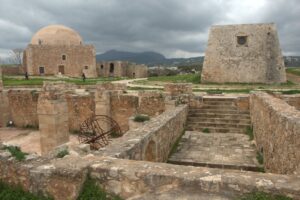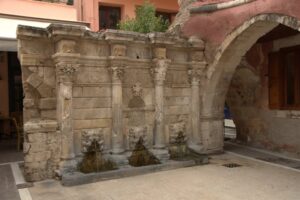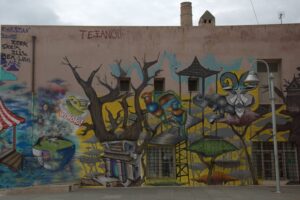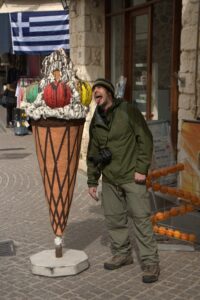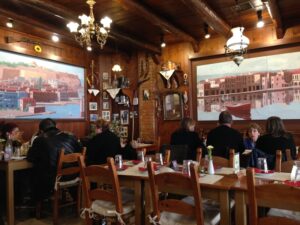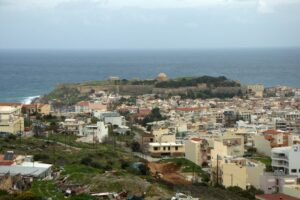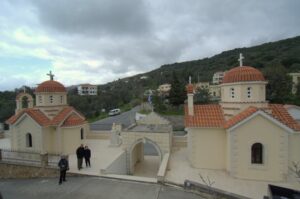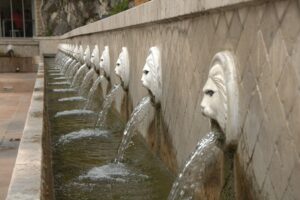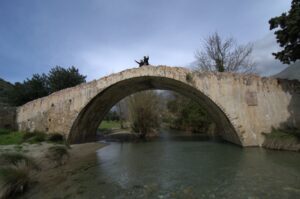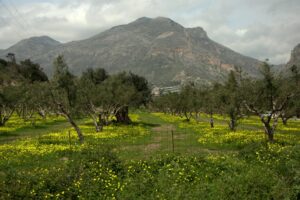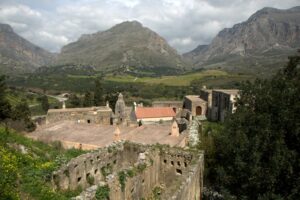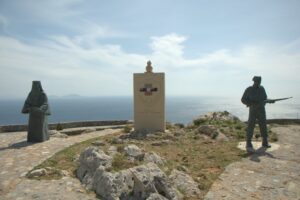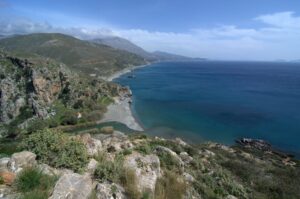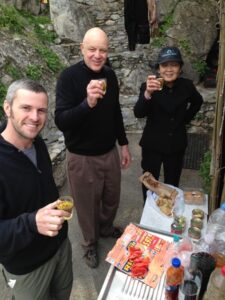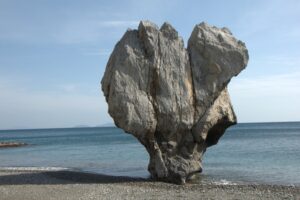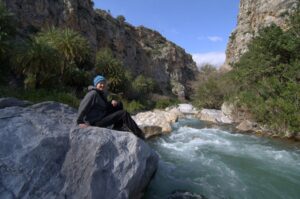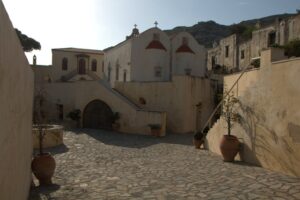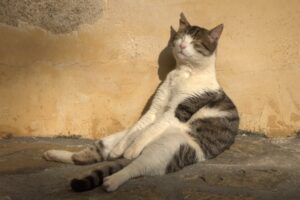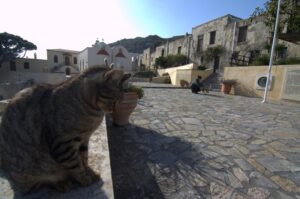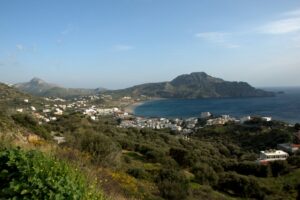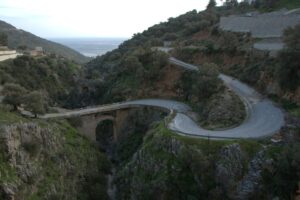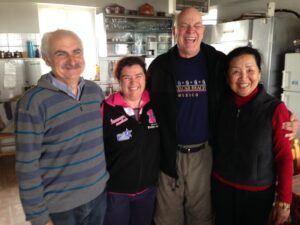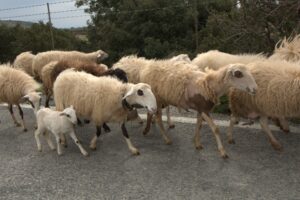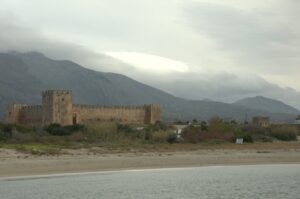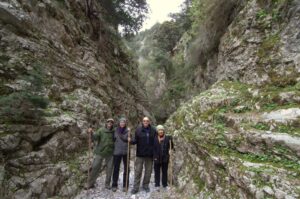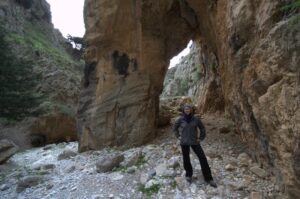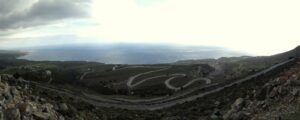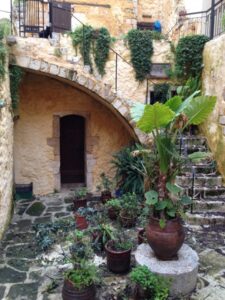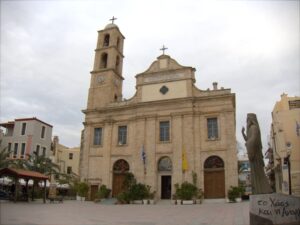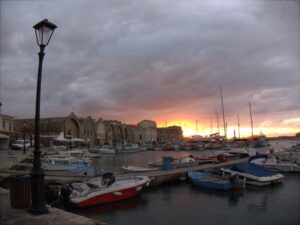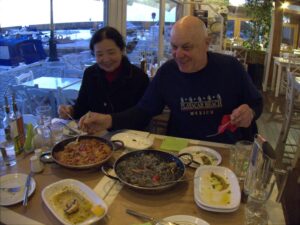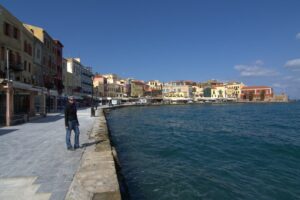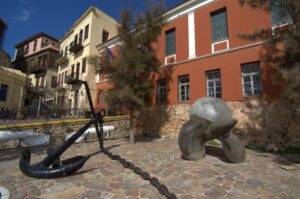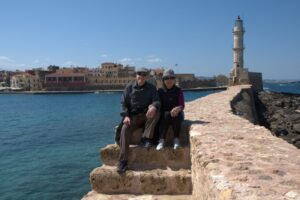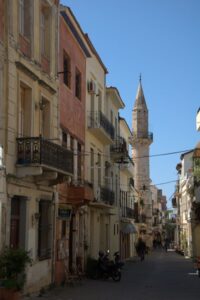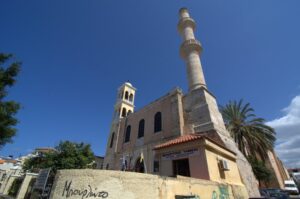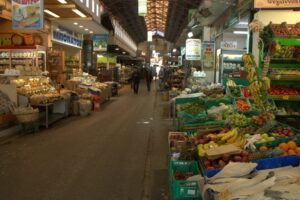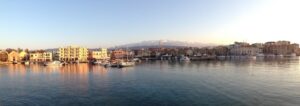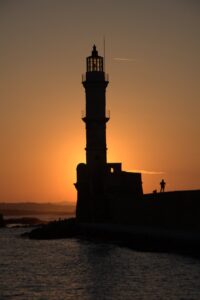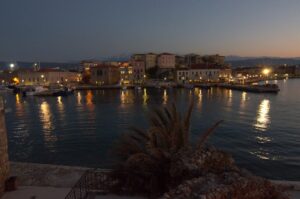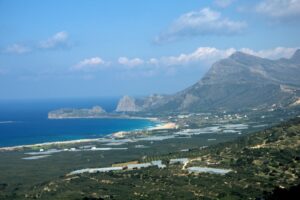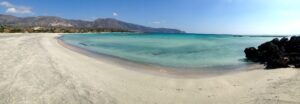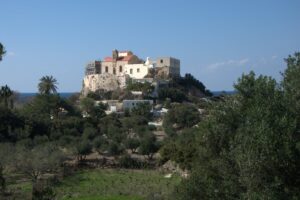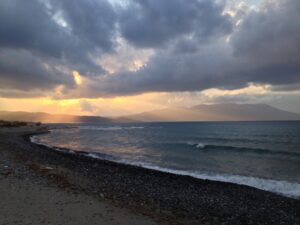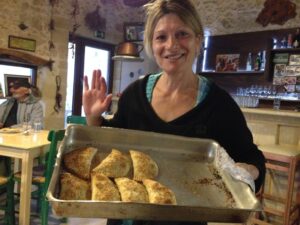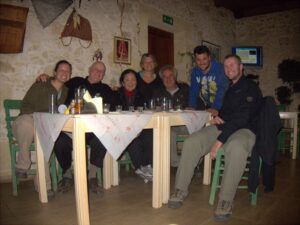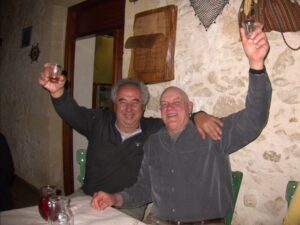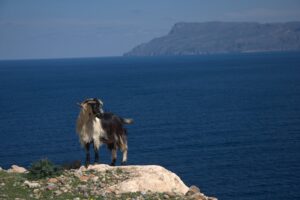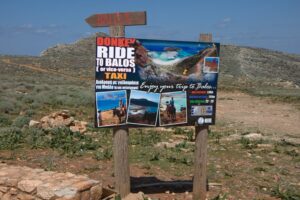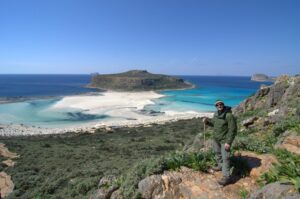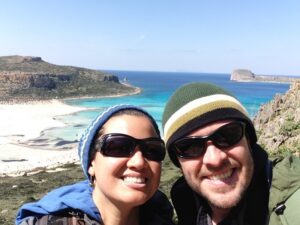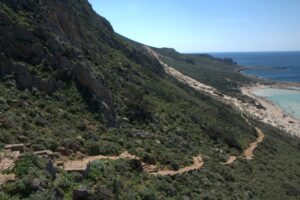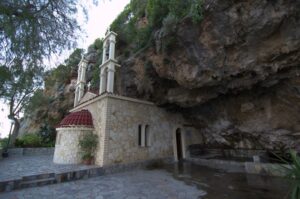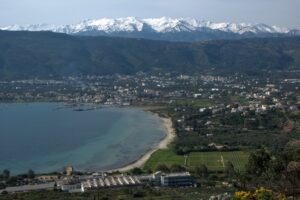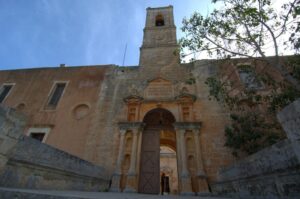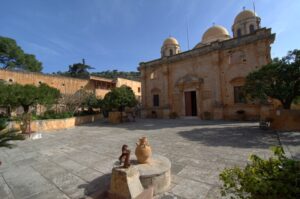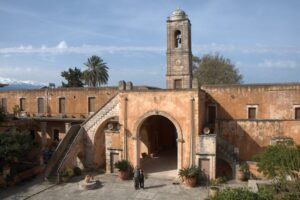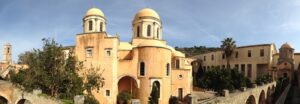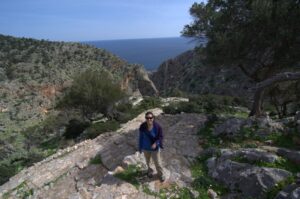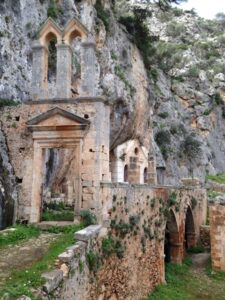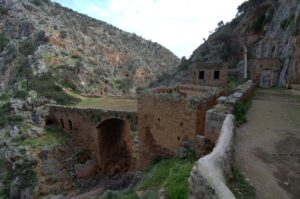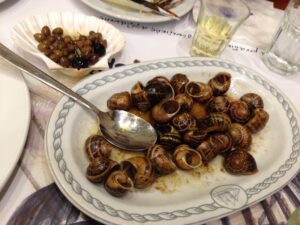The largest of the Greek islands, Crete surpassed our expectations. Prior to visiting, all we knew about Crete was the Minoan Palace of Knossos. But Crete offers so much more. Some of the island’s other highlights included the excellent seafood in its capital city of Heraklion, the mountain village of Kritsa’s church, pretty Agios Nikolaos, the medieval Venetian-Ottoman city of Rethymno, Arkadi Monastery, the palm forested beach of Preveli, Imbros Gorge, the old Venetian harbor of Chania, the pink sand beach of Elafonisi, the phenomenal family and food at Maracaibo restaurant (near Kissimos), the spectacular Balos Beach, and the pretty monasteries of Akrotiri Peninsula. Simply put, Crete is our favorite Greek island, and that is saying a lot given our love affair with the Greek islands.
12 Mar 2015: Our alarm sounded way too early at 5 am. The reason we were waking up at 0-dark-thirty? We had a flight from Istanbul to Heraklion (via Athens) today. Being the cheapies that we are, we opted to take public transpo from Sultanahmet to the airport. Luckily, the tram/metro starts running again at 6 am. After checking out of the perfectly located Eski Konak hotel (hostess Sofia is the best), we lugged our gear up the hill to the tram stop. A bit of confusion reigned as Bob insisted that we did not want to hop on the tram headed in the direction of Bağcılar. We knew better and jumped on the tram but with the doors closing and Bob and Ann still on the platform, we decided to hop back off so we could travel as a group. Unfortunately, another couple saw what we were doing and in a panic, they hopped off the tram too! Imagine their dismay when we all realized that we did indeed want a tram headed to Bağcılar. They shot our group dirty looks as they hailed a taxi (a pricey mistake) to the airport. Since we had plenty of time, we settled back and waited another 10 minutes for the next tram to Bağcılar, hopping off at the Zeytinburnu stop. From Zeytinburnu, it was a short metro ride to the airport where we tried to check in for our Aegean air flight. Good thing we had plenty of time because Expedia struck again! Of course there was a problem with our tickets at check-in…Expedia had modified our e-tickets due to a flight change on the Athens to Rhodes sector, but hadn’t reissued valid tickets. We thought this had all been sorted out ahead of time, but weren’t shocked to find out that there was still an outstanding issue. Directed to resolve it at the Aegean ticketing desk, we trudged over there and were finally issued new e-ticket numbers. Whatever disconnect there is between Expedia and Aegean followed us throughout the entire trip (from Heraklion to Rhodes to Santorini and back to Istanbul)…it was such a hassle to check in for all of our Aegean flights, with the check-in agents conferring with each other in heated, whispered discussions before begrudgingly issuing our seat assignments. We have learned our lesson to NEVER book with Expedia again…it would be better to have booked directly with Aegean for better customer service. The two hour layover in Athens flew by and before we knew it, our flight landed in Heraklion where we hopped in a taxi for the short 2 KM (10 Euro + 2 Euro baggage surcharge) ride to the excellent Kastro hotel. Check-in was a breeze and we were each given a 4th floor balcony room with a view of the nearby sea. After stocking up on some water and yogurt at a nearby supermarket, we were ready for dinner. The receptionist recommended a nearby seafood restaurant named “Ouzeri tou Terzaki” and for that, she deserves a massive hug. It was excellent and what a way to kick off our trip!!! We were the only tourists in this tiny restaurant full of locals. Our super friendly waiter handed us a paper menu and pen to select whatever offerings caught our eye. We decided to order several items from the menu: fresh bread with tzatziki (yum), olives, fish salad (served in a massive sea shell), fish soup (worth returning for), grilled octopus, red mullet, grilled snails in balsamic sauce (phenomenal), and several liters of house red wine. It was perfection…our waiter plied us with ouzo and brought out raki (which he jokingly called “Greek water”) followed by a massive plate of fried dough balls smothered in honey and cinnamon and a fruit plate (all on the house). One of the most amazing seafood meals ever! We felt lucky to have been recommended this gem of a restaurant and vowed to come back again tomorrow night. After a short stroll by the harbor front, we returned to the hotel to crash for a good night’s sleep.
13 Mar: Kastro hotel offers a great selection of fruit, veggies, meats, cheeses and pastries for breakfast. Since today was a full day of sightseeing, we got an early start by grabbing breakfast right when the buffet opened at 7:30 am, sampling a little bit of everything until we were stuffed. Ann particularly enjoyed the Greek yogurt with honey, while Becky raved about the baked pastries stuffed with cheese and the chocolate cake-bread. Heraklion is an easy walking city and our hotel was perfectly located for us to take in all the highlights. First up was a visit to the Church of Ayios Titos right off the main pedestrian street, followed by a brief stop at the 17th century Venetian Loggia (once a gentlemen’s club but now functioning as the town hall). Next, we sauntered into the 13th century Agios Markos Basilica, which is now the Municipal Art Gallery showcasing the local talents of Heraklion’s artists. The Morosini Fountain on Plateia Venizelou is more commonly known as the lion fountain (named after the four lions’ heads that used to spout water). Here, we were accosted by waiters from the nearby restaurants to grab a bite to eat. From the fountain, it was a straight shot across the street to the market area which was full of shops selling Cretan souvenirs. Eventually the market turned into a fresh fruit and vegetable market as well as a fish market. All one’s shopping can be done here! At the end of the pedestrian walkway, we stumbled upon the Turkish pumphouse, which today functions as an outdoor café. Behind it, renovations to the Bembo Fountain prevented us from checking it out. The Heraklion Archeological Museum was next on our agenda, as we had read that it was a must visit before Knossos Palace. Entrance was a hefty 10 Euros each (including Knossos Palace), but we quickly determined the museum to be good value. This treasure trove of a museum had countless displays of pottery, figurines, gold jewelry, sarcophagi and in the floor upstairs, famous frescoes taken from Knossos Palace. We were particularly impressed with the bull leaping fresco (a double jointed acrobat performs a somersault across the back of a charging bull), as well as the “saffron gatherer” fresco which portrayed a monkey picking saffron crocuses and placing them in a basket. We had timed our visit perfectly, as torrential rain poured down outside. By the time we were ready to exit, the rain had eased up to a light drizzle, and shortly after that, a brilliant sun came out from behind the clouds. Since our plan was to be in Greece for the greater part of a month, we figured a local SIM card would be a smart buy so we headed over to the nearest Cosmote center on Dikeosinis 67 to purchase and register our SIM. What a chaotic and busy place! The concept of queuing is a bit of a foreign concept and we had to be slightly aggressive to prevent other customers from jumping ahead of us in line. In the end, the hassle was worth it as it cost a mere 5 Euros for the SIM card and registration, and we bought several hundred minutes for a few Euros more…great value! From here, we decided to check out the Koules Venetian Fortress by the old harbor jetty. We passed by the vaulted arcades of the Venetian Arsenal (located on the harbor front, opposite the fortress) on our way to Koules Fortress. Under the Venetians, this 16th century stout landmark was referred to as “Rocca al Mare”. It is Heraklion’s main landmark, having been transformed from a fortress to a Turkish prison (for Cretan rebels), and today functions as a 26 restored room art exhibit and performance center. Unfortunately for us, Koules Fortress was under renovation, so we didn’t have a chance to check it out. The afternoon weather turned a bit fickle…the sun ducked behind some stormy clouds and we had to pull out our rain jackets when an afternoon rain shower decided to drench the city. Our last stop of the day was a visit to the Cathedral of St Minas (patron saint of Heraklion). This massive church is one of Greece’s largest, with a seating capacity of 8,000. The ceiling frescoes were a highlight as well as the unexploded WWII bomb just adjacent to the church (a proud symbol of one of Saint Minas’ miracles). In the square just below the church, Bob and Ann happened upon a store geared for local Cretans, selling a variety of homemade products. A shopping spree ensued, as we stocked up on local wine (housed in a plastic bottle for the cheapest price), bread, cheeses, olives, almond raki, wild artichokes, olive soap, carob, and fruit. All this while the proud owners plied us with free samples of meat, cheese and raki. What a great find! With our arms heavily loaded, we briskly headed back to our hotel, making only one short detour at a supermarket to buy some wine glasses. After dumping everything off in our rooms, we made a beeline back to our favorite Heraklion establishment, the excellent Terzaki seafood restaurant. Our friendly waiter from last night immediately recognized us and ushered us to a table where he took our order before mournfully informing us that he had to leave early tonight and would have to hand us off to another waiter. Our dinner feast included some favorites from yesterday: fish salad, fish soup, grilled sardines, snails, calamari, tzatziki, bread, and wine. Our new waiter forgot the snails, but quickly made up for his mistake by bringing us a free jug of wine, accompanied by the snails a few minutes later. Perfection! To top off our impeccable dinner, our waiter brought raki, fried cinnamon/honey dough balls, and something like a sweet yogurt that was not quite frozen but tasted like ice cream…yum! The desserts and raki were on the house, solidifying our love of Crete! What an island…our first impression of this massive Mediterranean isle was very, very positive!
14 Mar: After another great breakfast, our bags were packed and we were ready to go…time to explore the rest of Crete! Becky had coordinated a car rental from a company that had rave reviews on the internet (Anna Cars, sales@rentacar-crete.eu), opting for a Skoda Roomster. Since everything was settled via email without prepayment, we hoped that the company would live up to its reputation, and that a representative would show up this morning at our hotel as advertised. We needn’t have feared…by 8:30 am, our car was parked just outside the hotel and a rep was in the lobby going over paperwork and answering our questions. It was unbelievable how easy and straightforward the transaction was…for 300 Euros, we had the car for 9 full days with unlimited miles, an extra driver, and full comprehensive insurance with no excess and no deposit. Since we paid in cash and didn’t give any of our credit card details, we were amazed that there would be no hidden or surprise charges later. Two thumbs up for Anna Cars! The car was immaculate, surprisingly spacious, and absolutely perfect for zipping about the island. Our bags appeared to have multiplied, but with the Roomster’s generous trunk space, we had more than enough room to store all of our luggage. After checking out of the hotel, we easily made our way to the “highway” in the direction of Agios Nikolaos, about an hour’s drive east of Heraklion. The car had a quarter tank of gas, and we were instructed to return it with the same amount of fuel. Even though we had been reassured that we could make it to Agios Nikolaos without having to fill up, we opted to err on the side of caution and topped off the car. Driving in Crete is really easy and straightforward, with good signage everywhere for the most part. The only thing we had to be wary of were super aggressive drivers. Our drive was easy and scenic, and as we entered the Selinari Gorge, a monastery in the distance caught our eye. Since we had nothing but time on our hands, we decided to pull over for a quick look. Parking would definitely be a problem here in peak season, but we had the entire Agios Georgios Selinari monastery complex to ourselves. Dedicated to St George, we read that the small church dated from the 13th century, while the other churches and monks’ rooms were built in the 20th century. What a picturesque spot! From here, we continued on to Agios Nikolaos, orienting ourselves quickly with the town’s layout before deciding to drive onward towards the mountain village of Kritsa (krit-sah). Located about 11km southwest of Agios Nikolaos, it didn’t take us long to reach our next destination. Krista is reputedly one of Crete’s oldest and most picturesque villages, “built amphitheatrically on a rock hill, named Kastellos, surrounded by olive groves, at an altitude of 375 m.” Our guidebook cautioned us on the aggressive and insistent techniques of embroidered goods sellers, but we didn’t encounter anyone touting their wares. In fact, we were just happy to have made it to the upper village of Kritsa in our compact car! This is definitely a place to park and walk, but Robby felt confident in his driving abilities, and he managed to successfully squeeze us in and out of some super tight and narrow spots in Kritsa. Others had not been so lucky…the sides of the narrow alleyways of Kritsa are scarred with scraped paint and deep grooves from one too many a car becoming a casualty. After walking about the compact village, we decided to check out the 13th-century Church of Panagia Kera, located about 1km below Kritsa village. We read that the Byzantine frescoes of the church are some of Crete’s most photogenic. To our dismay, the church was locked up so we snuck a peek through its windows and can attest to the frescoes being noteworthy. Luckily, a lady working down the street suspected we were tourists and she came running up with a key, asking if we were interested in visiting (3 Euro admission per person). The frescoes alone were well worth the effort in visiting Krista, and we thanked the lady for making a special effort to allow us to visit. She mentioned that since it was off season, boats to Spinalonga (leper island) were few and far between, but if we were in the neighborhood later next week, she could organize a day trip for us by consolidating a bunch of tourists together. We told her we still had the rest of the island to explore and would be departing Agios Nikolaos tomorrow, but it was sweet of her to offer to arrange a visit for us. From the church we drove back towards Agios Nikolaos, and then onward to Elounda. The beautiful 11km drive north included spectacular mountain and sea views, and we decided to pull over in Elounda to enjoy a leisurely picnic by the fishing harbor. After lunch, we decided that even though we couldn’t visit the Leper Island of Spinalonga (boats don’t start running regularly until 1 April), we could check it out from afar. The turquoise hued water surrounding Spinalonga looked inviting for a dip, but it was way too early in the season to be contemplating a dip in the Med! After puttering about the mountains above Spinalonga, we drove back to Agios Nikolaos where we quickly found our apartment, Relax Studios & Apartments on Sofokli Venizelou & Heimaras 2. The building’s entrance was locked, but a lady working at the adjacent store saw us trying to work out how to get in and she offered to call the owner for us. Within minutes, we had checked in and were admiring the view overlooking the harbor. Relax Studios was a great budget option (25 Euros a night including free wifi and free parking street side). The owner told us we were the season’s first visitors, so he was still busy with last minute touchups to get the building ready for business. Our apartments were fantastic…super clean, compact kitchen, centrally located and a great view. After several shots of almond raki (yum), we decided to check out Agios Nikolaos. According to our guidebook, this seaside resort town stands on the “shores of the beautiful Mirabello Bay. The town’s harbor is linked by a narrow channel to the circular Voulismeni Lake. The main harbor-front road crosses the channel by a bridge and the pedestrianized lakeside is lined with cafes and restaurants. By day there’s a cheerful buzz around the harbor and by night a decidedly chic ambiance descends on the cafes and bars, where stylish young Greeks strut the harbor-side catwalk and holidaymakers pour into town from the neighboring resorts.” Agios Nikolaos is an easy town to explore by foot, and we quickly discovered that both restaurants we had earmarked in our guidebook to check out were closed (too early in the season). So we wandered around town searching for a backup restaurant, admiring the pretty lake and harbor-front scene. After checking out countless cafes, bars, and restaurants, we finally settled on a seafood restaurant where we ordered tzatziki, dako, seafood pasta, burgers, lamb chops, and beer. Even though the town definitely caters for tourists, the food was pretty decent. We can definitely see the appeal of pretty Agios Nikolaos even though we only spent a day here.
15 Mar: The spare blankets in the closet proved handy as it was quite a chilly night, but we all slept comfortably. After enjoying a hot shower followed by a self-catered breakfast, we bid Agios Nikolaos farewell as we drove towards Crete’s most famous attraction, Knossos Palace. The internet is full of horror stories about visitors to Knossos Palace suffering through insanely long lines and stifling hot weather draining one’s energy. Luckily for us, visiting off season once again rewarded us with a very pleasant visit. The free parking lot was empty of cars, so we parked right next to the entrance and got in with our Heraklion Archeological Museum ticket combo. The 3500 year old Minoan Palace of Knossos is spread out over a vast complex of ruins, many of them reconstructed with colorful frescoes and painted columns. The excavations were carried out under the watchful eye of English archeologist Sir Arthur Evans. We particularly enjoyed the throne room and dolphin fresco, and were very glad that we followed the advice to visit the Archaeological museum in advance of Knossos Palace as it helped us appreciate our visit more. From Knossos, we decided to head towards the mountain village of Anogia, which is famous for its slow roasted lamb. Located a mere 37km southwest of Heraklion, we hoped to reach Anogia just in time for lunch. According to our guidebook, Anogia is perched aside Mount Psiloritis, and it is famous for its rebellious spirit and 2000+ guest weddings (involving the entire village!) “During WWII, Anogia was a centre of resistance and suffered heavily for it. The Nazis burned down the town and massacred all the men in retaliation for their role in sheltering Allied troops and aiding in the kidnapping of a Nazi general. Hence, most of the buildings you see today are actually of relatively recent vintage, yet Anogia seems to desperately cling to time-honored traditions. Black-shirted mustachioed men lounge in the kafeneia, baggy pants tucked into black boots, while elderly women hunch over their canes, aggressively flogging woven blankets and embroidered textiles displayed in their shops”. We didn’t see the mustachioed men or hunch-backed elderly women, but we did find a fantastic local restaurant where we ordered up a kilo of lamb, fried pumpkin, fries, and jugs of homemade red wine. Our meal was quite tasty, and the restaurant quickly filled up with local families who had just come from church. The lamb alone was worth the detour to this quirky mountain village. After our main meal, the owner brought us free raki and a cheese tart covered in honey that was surprisingly good. We love the Cretan tradition of serving free raki and dessert after every meal! After lunch we intended to drive towards Rethymno, but the road was poorly signposted and we got hopelessly lost, inadvertently driving a full loop around several mountain villages. After studiously checking out our map to figure out where we went wrong, we finally backtracked to the correct road and found our way. Our original plans were to visit Arkadi Monastery in the afternoon, but we had lost too much time and didn’t want to rush our visit so we opted to delay our visit for another day. Instead, we drove directly towards Rethymno. Good thing there was still plenty of daylight left as it would have been a nightmare trying to find our hotel in the dark! After driving in endless loops around the historical core of Rethymno, we decided it would just be easier to park and walk the city by foot. Our quest was to find our lodging for the night, Rethymno House located on Vitsentzou Kornarou 3-5 in the medieval Venetian-Ottoman quarter of the city. It took a while but we finally found our pension tucked away in a narrow alley. After meeting the ever friendly owner, Nikos, we walked back to retrieve the car so we could offload our bags closer to our hotel. To our dismay, a coveted parking spot that had been free mere minutes before had already been scooped up, so after dropping our bags off in our respective rooms, we drove around in search of a place to park the car. Happily, we found a free parking space just a few minutes away, which was great as parking in Rethymno can be a nightmare! Nikos jokingly told us that the parking police are all on strike…this meant we could literally park anywhere and not get a ticket these days! Bob and Ann were lucky to get a street side room that had a Turkish Balcony with views down one of Rethymno’s main streets (earplugs are a necessity in this party, college student town!). After Nikos gave us a run down on all the things to do and see and where to eat and go out for drinks/entertainment, we chilled in the room for a bit before heading out for dinner. Dinner was a gyros place on the main square near the Kara Musa Pasa mosque. A meal for four including beer and water came out to an unbelievable 16 Euros…what a bargain! And the pork gyros sandwiches were massive and tasty to boot. We were so stuffed that we strolled right past the ice cream stands that had looked so tempting mere moments before.
16 Mar: It was a loud and boisterous night as the college students of Rethymno partied in the streets. Our plan for the day was to make a quick detour out to Arkadi Monastery for a morning visit, followed by a walking tour of Rethymno. Breakfast was a self catered meal in the room. Surprisingly, our pension didn’t have a kitchen so we had to run the hot water just long enough to make some coffee. Retracing our steps from yesterday, we managed to find our car on one of the side streets. A lucky Rethymno visitor happily took our parking spot…parking in this city is a nightmare with way too many cars and too few parking spaces. Nikos had told us the most direct and easiest way to find Arkadi Monastery (23km southeast of Rethymno) and his directions were spot on. Ann’s sore throat had been bothering her for the past few days, so upon spotting a lemon orchard en route to the monastery, Bob hopped out and pilfered a couple for her lemon/honey concoction. We were happy to have bundled up for the day, as it was a chilly morning up on the foothills of Mount Ida, where the beautiful Moni Arkadiou (Arkadi Monastery) is located. To our surprise, a bus full of Greek tourists had arrived early to be the monastery’s first visitors of the day. We had no idea the monastery would be so popular, even in the off season! Entrance to the monastery was a reasonable 2,50 Euro each. We had read that the “most impressive building here is the 1587 Venetian Church, which has a striking Renaissance façade marked by 8 slender Corinthian columns and topped by an ornate triple belled tower”. It is the first sight that greets all visitors to this lovely monastery, and the arched entranceway provides a perfect frame for a photo. While visiting Arkadi Monastery, we learned that it is one of the most visited sites in Crete, and serves as a symbol of self-sacrifice and heroism. This is due to the important role it played in the Cretan Revolution against the Turkish occupation in 1866, infamously named the “Arkadi Tragedy”. In the 19th century, the monastery was used as a hiding place for Cretan revolutionaries fighting against the Turkish occupiers. Their munitions were stockpiled behind the monastery’s thick stone walls. In 1866, over 1600 Turkish troops surrounded the monastery. Unable to prevent them from storming the gates, the 1000 or so resistance fighters (as well as women and children who had sought refuge at the monastery) decided to choose death rather than surrender. Their defiant last act in refusing to be taken prisoner by the Turks was to set fire to their own gun powder magazine. This mass suicide by the besieged inhabitants shook public opinion around the world and turned Arkadi into a symbol of the struggle for liberation. Today, Crete commemorates the event each November with fireworks and dancing. After our enlightening visit to Arkadi, we returned to Rethymno and searched around for a parking spot, finding one right next to a Greek Orthodox Cathedral in the center of town. Of course, to get to it we had to lift up a barricade, but other visitors had set the precedent and were parked nearby so we felt confident that our rental wouldn’t be ticketed. The rest of the day was spent exploring Rethymno by foot. Our guidebook describes the city as “basking between the commanding bastions of its 15th-century fortress and the glittering azure waters of the Med, Rethymno is one of Crete’s most delightful towns. Crete’s third-largest town has lively nightlife, some excellent restaurants and even a decent beach right in town”. Our pension was perfectly located to explore the old quarter of Rethymno…we were mere footsteps away from the picturesque Venetian harbor. From there, it was a short walk to the 16th century Venetian Fortress, which was built to counter multiple pirate raids and protect the city against the mounting threat from the Turks. Even though there is supposedly a 4 Euro entrance fee to visit the fortress, the ticket booth was vacant, and we noticed that everyone was able to visit for free during the off season. Even though the fortress has massive (and perfectly intact) walls, the numerous buildings the fortress once sheltered have been destroyed and today only a church and a mosque remain standing. There are great views of Rethymno from the ramparts, and we took our time admiring the panorama. From the fort, we made our way down into the old quarter, visiting the Rimondi Fountain (spouting lion heads and Corinthian capital columns) and the nearby Loggia (once a nobility meeting house, but today functioning as a museum/gift shop). Rethymno is an architectural gem, full of Venetian mansions and Turkish balconies (made of timber overhanging a few feet into the street). We wandered through the “Porta Guora” (great gate), which is the only remnant of the Venetian defensive wall of the city. The triple domed Neratzes Mosque is one of very few remaining Ottoman structures, but unfortunately it was undergoing renovations when we visited. By this point we were ready for lunch so we checked out a Greek taverna, Ta Agrimia, recommended by Nikos. We had high expectations as everything else in Crete had been a winner thus far. But, alas, our winning streak came to an end…the food (avocado salad, lemon lamb and mixed grill plates) and service were mediocre. We did notice that a nearby table was being attentively serviced, but then again, the two patrons sure could eat! They put away a shit-ton of food and drink, culminating their meal with the obligatory bottle of raki and dessert. We felt lucky to get a plateful of fruit…no raki as Ann observed though! Everyone was game for an afternoon siesta, followed by snacks and drinks in Bob & Ann’s room until midnight.
17 Mar: After a self catered breakfast, we stuck our keys in the door and left the pension…we hadn’t seen Nikos or staff since check-in but since the bill had already been settled (30 Euros per room per night), we didn’t feel bad leaving without a goodbye. Metal barricades to deter traffic had been erected since we parked our car at the cathedral, but Bob quickly discovered he could simply lift one of them up to allow us to drive through! Nikos certainly wasn’t joking when he said that the inhabitants of Rethymno had certainly taken advantage of the lack of police presence…cars were illegally parked throughout the city with nary a ticket in sight. Today’s agenda was to drive to the south of Crete, stopping in Spili, Preveli and making our way to overnight near Frangokastello. We left Rethymno’s chaotic inner city roads and headed south up into the mountains, pausing for a brief stop to overlook the island’s third largest city from a higher vantage point. Our drive to Spili was easy, and our first stop was at the village’s supermarket where we stocked up on groceries for a picnic lunch. A church complex had caught our attention on the drive in, so we checked it out briefly before backtracking towards Spili’s famous draw card, its fountains. A series of lions’ heads spouting water makes Spili a popular coffee stop by its serene water fountain. We enjoyed this rustic town for about an hour before making our way towards Moni Preveli (Preveli Monastery). The road was well sign posted (we followed signs towards Plakias and Preveli), and the drive was quite spectacular as it passed through the Kourtaliotiko gorge. We stopped for photos of the gorge, but had to contend with the super strong winds that were being furiously funneled through. Bob and Robby wanted to make a roadside pee stop, but due to the strength of the wind, were petrified of backsplash or inadvertently soaking Ann and Becky so they were given a wide berth! Robby spotted an abandoned old church (Agios Nikolaos) in the ravine of the gorge, so he decided to sprint down to check it out. Little did he know how far he would have to go…by the time he had retraced his steps back to the car, he was huffing and puffing, trying to catch his breath and removing layers of clothing to stop the profuse sweating. The rest of us were happy to have opted out of the excursion! Eventually, we stumbled upon a scenic old Turkish bridge that spans the Megapotamos River. Apparently, this is one of a few rivers in Crete that flows all year long. We learned that the Turkish bridge was built in 1850 for the monks of Preveli…it is in remarkable shape and well worth a stop. From here, we drove past the ruined monastery of Kato Preveli (closed to visitors but worth a peek from the road). The road kept ascending upward and we quickly reached a monument commemorating the resistance of Preveli’s monks against the German invaders of WWII. The monks are famous for helping to evacuate Allied soldiers (UK, AUS & NZ) off the island of Crete to Egypt. One of the statues is of a monk proudly posing with a rifle…talk about hard core monks! We kept driving until we reached Preveli monastery but discovered to our dismay that it was closed. According to the visiting hours, the monastery would be open again in a few hours for afternoon visitors so we decided that it was a sign for us to have our very own afternoon siesta. We had the perfect place in mind…the palm forested beach of Preveli. Remember the Megapotamos River under the Turkish bridge a few kilometers back? Well, apparently it flows towards the sea, cutting straight through the palm forest of Preveli. From our pre-trip research, we read that “Preveli Beach (aka Palm Beach) is one of Crete’s most celebrated strands. The setting is truly stunning. The beach sits at the mouth of the Kourtaliotiko Gorge, from where the river Megalopotamos slices across it before emptying into the Libyan sea. The palm-lined riverbanks have freshwater pools good for a dip, while rugged cliffs begin where the sand ends. A steep path leads down to the beach (10 minutes) from a car park 1km before Moni Preveli.” The steep path actually took us about 20 minutes going down…luckily, Robby had found the perfect bamboo hiking poles for us, which helped Ann’s bum knee on the precarious path down. Our beach picnic was freaking awesome. The sun was out, the weather was briskly cool but pleasant, and we had the entire beach to ourselves…not a single soul in sight! We set up our lunch extravaganza next to an empty taverna, laying out a spread of cheese, sausages, tzatziki, bread, fish, wine and sesame desserts…utter perfection. Afterwards, Becky waded across the frigid river for a photo of a massive rock at the edge of Preveli beach. The water was definitely way too cold to contemplate a dip in March! Perhaps late April or early May, but only members of the polar bear club would enjoy a swim in March. We strolled through the palm forest and can definitely see the appeal of Preveli Beach…the setting here is spectacular!!! The hike back up to the parking lot only took us 15 minutes. It felt a lot easier hiking up than down because we weren’t afraid of losing our footing and taking a tumble down the path. The hiking poles helped considerably. Fingers crossed the monastery would now be open and we were in luck. We were happy to discover that even during the off season, the monastery abides by its opening hours. Our guidebook described the historic Moni Preveli as standing in “splendid isolation high above the Libyan sea. Like most Cretan monasteries, it was a center of anti-Ottoman resistance and was burned by the Turks during the 1866 onslaught.” There were no other tourists around and no entry fee to visit the monastery, but the museum was closed. We did sneak a peek inside the church but two monks were praying so we decided to leave them be in peace. The cats of the monastery definitely stood out. They were definitely longing for human interaction…they approached us like dogs and followed our every footstep. Perhaps they were looking for food? Or simply a free petting? Their behavior was riveting…the cats of Crete definitely march to the beat of a different drum. If you dared to kneel on the ground for a photo, they came a-running, hopping up into your lap before you could dissuade them from doing so. We loved the uber friendly cats of Preveli. It was late afternoon by the time we left the monastery, and we thought it would be a short drive to Frangokastello. What we hadn’t accounted for were the curves of the road! It took us double the time we had estimated, but the drive was quite scenic. Our lodging for the night was a B&B called Zorbas Rooms in Lakkoi Skalotis, several kilometers away from Frangokastello. We were doing great up until we came to an intersection…all the other guest houses seemed to be down a road leading to the beach. But the Zorbas sign had disappeared so we kept going straight, worrying as the road became a rough dirt patch, followed by a rocky and muddy mess leading down to a small church next to the beach. We kept thinking there was no way our guesthouse was down this super rough terrain. Surely someone would have mentioned the treacherous road in one of the many flattering reviews? After an SOS phone call to the lovely owner of Zorbas, we retraced our steps and found her waiting anxiously for us on the main road. Our first instinct to follow the signs of all the other guest houses was right…that morning, a huge gust of wind had actually blown down the Zorbas signpost…we saw it crumpled near the ground and jokingly told the owner that it should be fixed. The wind was blowing something fierce as we arrived to Zorbas. Our kindly owner immediately plied us with welcome raki, followed by snacks and more raki. The entire family and neighborhood plied into the kitchen to greet us with true Cretan hospitality. We were the first guests of the season, and the neighbors curiously checked us out. We didn’t want to get too tipsy before dinner, so we begged off and asked if we could be given our room keys so we could settle in. Bob and Ann ended up switching rooms (the owner graciously complied with their request of two twin beds vice a double). Bottles of raki were for the taking in our room, but we decided we needed to eat something first before imbibing in more drink. Dinner was a homemade Cretan meal. Bob and Robby enjoyed rabbit with local greens while Becky and Ann opted for the less exotic hamburger patties with fries. Dessert was yogurt with local marmalade fruit (similar to orange mixed with grapefruit). The owner proudly told us that eco-tourism in this remote pocket of Crete was taking off, with tourists interested in experiencing the “real” Crete heading here in droves. Everything in the kitchen was harvested locally, from the olives to the milk and cheese, to the pickled fruits, yogurt, wine and olive oil. We were very impressed at the self-sufficiency and tight knit neighborly cooperation that we witnessed. One family would make cheese and trade it with another family for their olive oil, etc. We stayed up late chatting with the family before finally calling it a night.
18 Mar: We had busy plans for today so we asked for breakfast to be ready by 8 am. Our breakfast spread of bread, a mixed variety of homemade jams, fresh butter, honey, cheese, olives and local tea/coffee gave us plenty to choose from. It was amazing that most of the items were handmade right there on their farm! Ann received a complimentary bottle of the family’s olive oil (nice gift!), while Becky settled the bill. Interestingly, our booking.com reservation showed that our credit card would be charged in full two weeks prior to arrival, and we saw a charge for 70 Euros (2 rooms plus 4 breakfasts) on our credit card bill that we couldn’t account for. So we just assumed that we had already paid for last night’s accommodation but the family was adamant that payment had not been handled yet. A quick phone call to the local booking.com office shed some light on the mystery…our card had been charged by a hotel in Rhodes, not Zorbas Rooms. Thankfully, the family was extremely gracious about the entire situation. We suppose it’s inevitable that mistakes will occur when you book two weeks’ worth of hotel bookings all at once, especially since some hotels charge in advance while others prefer to settle the bill in cash. After thanking our host family for their warm hospitality, we loaded up the car and drove the short distance to Frangokastello. This seaside castle was built by the Venetians in 1371, and it is an imposing presence on the southern coast of Crete. The castle is made in a simple rectangular shape, with four corner towers. Unfortunately, it was locked up when we visited so we took some photos from afar. It was an easy drive from Frangokastello to Komitades, where we planned to park the car and find some kind soul to drive us up the steep road north to the mountain village of Imbros. Even though the weather looked a bit sketchy, we figured today would be a beautiful day for a hike through the 8km Imbros Gorge. We could have started the hike in reverse, but hiking from south (Komitades) to north (Imbros) would have meant that we were hiking uphill the entire time, and we read that it’s much easier and pleasant to do the hike from Imbros to Komitades. But first we had to find a driver. Since it was off season, we weren’t sure if we’d be able to find someone willing to drive us to Imbros but a helpful villager pointed us in the direction of a nearby taverna. There, we knocked on the door until we woke up a man who had obviously had one too many to drink the night before! He gestured that he needed a couple of minutes to fully wake up, and soon we were all crammed into his tiny car, zipping up the curvy road towards Imbros. The ride was a bit scary as he took the corners way too fast, but we made it in one piece, happily paying him 20 Euros (5 per person) for the ride. Armed with our bamboo hiking poles, we donned on our snivel gear as the inclement weather combined with a strong wind at the top of the gorge chilled us all to the bone. Ann and Bob were wondering what the hell they had gotten themselves into as we had been sparse on the details, just telling them “it’s an easy hike…all downhill”. The Imbros Gorge is not as famous as its sister gorge, the uber popular Samaria Gorge (which runs parallel to Imbros). However, Samaria is only open for a few months each year (beginning of May – mid Oct), whereas Imbros is open year round, except during heavy rain and snowfall. We read that Imbros is equally as scenic as Samaria, but a bit shorter and without the crowds to contend with…it sounded like a no brainer to us! Admission to Imbros Gorge is 2 Euros, but since we were hiking during the off season, the ticket booth was unmanned and we got to hike for free. Our research into the Imbros Gorge revealed that our hike would cut through “300m high walls buttressed by cypresses, holm oaks, fig and almond trees and sage. Landmarks include a giant arch at the 2km mark (coming from the south) and the narrowest point of the ravine (near the 4.5km mark), which is just 2 meters wide. This trail is rocky (wear sturdy shoes) but it is easy to follow as it traces the stream bed.” The hike was spectacular…we had the entire trail to ourselves and the weather improved as we leisurely made our way down south. There were countless photo opportunities, and Ann’s bum knee didn’t give out on her despite the rocky (and sometimes precarious) trail. We saw several dead mountain goat carcasses strewn at various points along the route…we assumed they must have fallen off the treacherously high cliffs on either side of the trail. Our bamboo hiking poles were invaluable…at the end of the trail, we donated them so that other hikers could benefit from the added support. Our spirits were high as we completed the hike…definitely a worthwhile venture and we highly recommend it! From Komitades village, we piled into our car and drove up the numerous switchbacks leading up towards the mountain village of Imbros, pausing for a brief photo to capture the hairpin turns in the road. Then it was onward towards the charming village of Chania, where we would spend the next two nights. But first, a quick stop at a mountain side bakery for some sesame snacks (f-ing delicious…we would have bought more if we had sampled the goods before driving away) and ouzo shots. If you ever drive from Imbros to Chania and spot a bakery high in the mountains on your left hand side, do not hesitate! Pull over immediately and buy some of their baked goodies…they tasted like little gifts from heaven. We reached Chania before we knew it, and amazingly found a parking spot right next to the central market (a cross shaped building in the center of town). Our hotel, Vranas Studios, was conveniently located just a few minutes away near Mitropoleos Square. The friendly hotel staff gave us a warm welcome. Our rooms were fantastic…Bob and Ann scored a spacious room with a king sized poster bed, while we got a room with a balcony overlooking the cathedral in Mitropoleos Square. Awesome! Back at reception, we got the low down on Chania (best places to eat, what to see and do, etc). The super helpful receptionist told us that parking at the public market was free (the parking meters have been in-operational for several years now). She also recommended that we check out Glossitses restaurant if we wanted great seafood (located right smack dab on the old harbor just beyond the old covered Venetian shipyard). Chania is a beautiful city…we were immediately impressed by the old Venetian harbor. Glossitses did not disappoint. We wanted to hug the receptionist for recommending the restaurant…it was absolute perfection! First, the view was fantastic as the sun set over the horizon and painted the sky over the harbor beautiful shades of pink and orange. Second, the food and service were excellent. We ordered a liter of wine, rye pita bread, tzatziki, peppers, mushrooms, cuttlefish paella and octopus paella…mouthwateringly good! Our waiter was super friendly and entertaining. He was thrilled to hear that we had hiked the Imbros Gorge that morning, stating that we were experiencing the “real” Crete. We were stuffed after getting free raki, dessert and fruit…two thumbs up for Glossitses! The price for our feast was incredibly cheap (52 Euros!), and we would not hesitate to eat here again. After dinner we hung out in Bob & Ann’s room to talk about investing until they finally kicked us out at 10 pm! Overall, great day.
19 Mar: Yay! Robby had a complete day off from driving today. Yup, today we were Chania bound. After a nice sleep in, we finally roused ourselves and sauntered down to Bob and Ann’s room where a breakfast spread was laid out. Chania has the reputation of being Crete’s prettiest town, with a picturesque Venetian quarter of narrow lanes leading to a mesmerizing harbor. It’s an easy city to explore by foot, so we opted to leave the car parked next to the municipal market while we got lost in Chania’s nooks and crannies. Bob was keen on the Naval/Maritime Museum (3 Euros, open till 3pm during the off season), which is housed in a former Turkish prison. Full of memorabilia from the Battle of Crete, Bob found the museum fascinating but he felt rushed as he didn’t want to hold us up. Since we opted to skip the Maritime museum, the ruins of the adjacent Venetian fortifications of Firkas Fortress lured us in which took all of five minutes to check out. So we wiled away the time by soaking up the sun’s rays while hanging out on the fortress walls. Bob found it difficult to break free from the museum, so he asked its kindly owners if he could return for part II of his visit later that afternoon and was told it would be absolutely no problem. The restored Venetian lighthouse at the entrance to the harbor beckoned. It is an easy 1.5km stroll along the sea wall, offering nice panoramic views of Chania. After the lighthouse, we decided to check out the municipal market but first made a detour to the Church of Agios Nikolaos (just behind Splantzia Square). This church is unique in that is has both a minaret and a church bell tower. We could see them from the harbor front, and it was intriguing…half church, half mosque? Apparently, the Greek Orthodox Church was originally built in 1320. It was later converted to a mosque in 1645 and served as Chania’s main mosque. In 1918, Orthodox Christians of Chania once again took over the church and they dedicated it to Agios Nikolaos, the patron saint of sailors. The Venetian and Turkish influences on Chania are undeniable…from the Venetian fortifications to the Mosque of the Janissaries smack dab in the corner of the old Venetian harbor. Next up on our walking tour was the Agora market (municipal market), a huge cross shaped building housing stalls aplenty full of spices, honey, cheese, olive oils, wines, and souvenirs, as well as fast food eateries, and fruit/vegetable/fish markets. A photo gallery in the center of the market showcased old black and white photos of Chania through the ages. We saw that the central bastion of the old Venetian city wall used to stand beneath our feet, but it was demolished to make way for the covered market. Ann bought some meats and cheeses for a future picnic lunch. The food stalls made us hungry, so we went in search of another restaurant that came highly recommended by our hotel, the popular local eatery called “Kourina E.P.E.” Located on Daskalogianni 25, this low key restaurant serves up mayirefta (prepared dishes). Our guidebook explained that its “playful name means ‘Limited Liability Restaurant,’ but there’s no reason for concern – everything is great, from the sardines to the pastitsio (layers of buttery macaroni and seasoned mince lamb).” We were told to point at whatever interested us and grab a seat at any table…easy enough! Our choices were red wine, chicken in orange sauce, pork in honey and peppers, and cuttlefish with veggies. We were thrilled with our meal choices…tasty and cheap. Bob left early to go back to the naval museum, while the rest of us enjoyed a free bottle of raki and a yummy concoction of orange yogurt mousse…delicious! After lunch we loaded up on more food supplies at the nearby supermarket before heading back to relax in our room. By midafternoon, we decided to partake in a bottle or two of red wine before heading out to the waterfront to catch the sunset. It wasn’t as spectacular as yesterday’s magnificent sunset but we felt content, warm from the wine and hungry for some snacks. Back at the hotel, we put out a nice spread of food which satisfied our hunger pangs. Tonight was a repeat of last night, with Bob and Ann eagerly soaking up all our knowledge of investing and the stock market. Today was a nice, enjoyable, relaxing day.
20 Mar: Today we planned to visit Elafonisi, a pink sand beach tucked away in the southwest corner of Crete. We had also booked accommodation near Kissimos (the northwest portion of the island, near the famous Balos Beach). So that meant a lot of driving today! We had to set an alarm to get up for breakfast at 8am in Bob/Ann’s room. After checking out of the excellent Vranas Studios, we packed up the car while Bob and Ann popped into the central market for a bit of last minute shopping. Several cars circled by, eyeballing our parking spot but we had to wave them on…parking in Chania can be tricky and we weren’t about to give up our coveted spot before we were ready to go. After Bob and Ann returned with bags full of picnic goodies, we finally hit the road. Armed with GPS, we gave Robby directions to head out of town, stopping only briefly when Ann spotted some avocados for sale at a roadside supermarket…they were ripe and cheap, perfect for our picnic lunch! There are two ways to get to Elafonisi. The receptionist had recommended we drive down the coastal road (enjoying the magnificent views overlooking the sea below). That was the more scenic and circuitous route. She also recommended that after enjoying Elafonisi, we drive back to Kissimos via the more direct mountain road, which would bring us back to the northern side of the island in no time. We were grateful for her recommendation, as the drive out to remote Elafonisi on the coastal road was rather breathtaking. Thankfully, the road was well signposted albeit devoid of traffic. On one particular stretch of road, we were rather alarmed to see a man standing off to the side of the road with a shotgun in hand. He was lamely trying to hide the shotgun from us, which gave us further cause of concern. Then we spotted his pickup with a trail of blood in the flatbed…eerie! Further down was another hunter armed with a shotgun. We were very happy to drive past these two camouflage clad hunters as we had no idea what their prey was…unsuspecting tourists perhaps? After about 90 minutes on the curvy road, we finally reached Elafonisi. The last stretch of road deteriorated into a rough dirt road leading towards the sea…we drove slowly in our car, not wanting to blow out our tires. Our pre-trip research had revealed this about the highly touted pink sand beach, “It’s easy to understand why people enthuse so much about Elafonisi. At the southern extremity of Crete’s west coast, the beach is long, wide and separated from the Elafonisi Islet by about 50m of knee-deep water. The clear, shallow turquoise water and fine white sand create a tropical paradise. The islet is marked by low dunes and a string of semi-secluded coves that attract a sprinkling of naturists. Unfortunately this idyllic scene can be spoilt by the busloads of day trippers who descend in summer. The main attraction of Elafonisi is the beautiful sandy beaches fringed with pink coral sand and the crystal clear waters of the sea and the lagoon. As it is located at a remote corner of Crete you also get a sense of wilderness, being far from everything.” How does Elafonisi get its pink sand beach? Apparently there are lots of red and pink sea shells that get ground up by the sea action, depositing a soft hue of pink/red sand along the water’s edge. That, combined with the absolutely perfect turquoise hue of the sea, makes this destination a magnet for day trippers. Since we were visiting in the off season, we had all of Elafonisi to enjoy by ourselves, with the exception of a couple hard core windsurfers who were taking advantage of the day’s blustery weather. We sought shelter from the wind as we laid out our picnic spread…from salami to cheese, multigrain bread, tzatziki, olives, artichokes, almond raki, red & white wine, tuna, tomatoes, avocados and onions, it was a bountiful feast. Afterwards, we wandered up and down Elafonisi’s beautiful beach and tested the frigid temperature of the water…yup, way too cold for a dip. We can see the allure and attraction of Elafonisi, even in the off season! From Elafonisi, we piled back into our car for the drive back north towards Kissimos. Our lodging for the night was about 5km away from Kissimos, in the village of Nopigia. Azure Beach Villas is an apartment/pool complex that had just opened for the season, and we were the first guests to stay there this year. Even though we had been warned that the reception might be closed when we arrived, we were surprised to see someone manning the desk. Our two bedroom apartment had its own private pool, a nice kitchen, and plenty of lounging space. We were thrilled to see a washing machine as we had loads of laundry to wash. There was no dryer, but we quickly transformed our apartment into a makeshift refugee camp, stringing up laundry lines from one corner of the building to the other. We had asked if there were any nearby restaurants and were told to head into a nearby village for a place called “Maracaibo”. A quick look on trip advisor solidified our decision…rated #1 for all Kissimos restaurants, we wanted to see if it could live up to the hype. Boy, did Maracaibo not disappoint!!! We had a wonderful night…when we first walked in, there was a table full of locals playing cards and drinking. We weren’t even sure if the place was open for guests, but we were warmly welcomed and told to sit wherever we wanted. After grabbing a table, we were greeted by Georgios (Yorgos), who immediately brought us a flask of house wine. After sampling both the red and white, we voted that the white wine won hands down, even though Georgios preferred the red. Georgios’ wife brought out some appetizers, and we were asked what we were in the mood for. No menu, just a casual conversation of “what are you interested in”, followed by a “what do you have?” and so on. In the end, the scrumptious lamb chops won out, as all four of us ordered the same meal. It was a great choice…Maracaibo is a traditional Greek restaurant and they certainly know how to prepare lamb chops! Thrilled with our meal, and the ongoing hospitality (our wine flasks never got low), Bob and Georgios soon discovered they had something in common…they were both old seadogs! Once a sailor, always a sailor. The two of them were thick as thieves as the night progressed, laughing as the wine flowed and the tales of sea grew more and more farfetched. We originally thought Georgios owned Maracaibo (named after a city in Venezuela), but soon found out that his son, a young guy named Jiannis (Johnny) owned the restaurant. He was lucky enough to have his mom and dad work the restaurant for him. We loved the entire family…true Cretan hospitality at its finest. Super friendly, ever gracious, and hysterically entertaining, the family enthralled us. We promised to return again tomorrow night for a repeat visit. This was a big promise as we originally had no intention of staying an extra night in Kissimos! Maracaibo changed our mind…that’s how fantastic the restaurant is! Oh, and our bill for all four of us (food and drink) was a mere 39 Euros! That’s unbelievable great value…two huge enthusiastic thumbs up for Maracaibo.
21 Mar: We woke up around 8am and had a leisurely morning discussing stocks and eating breakfast. Since we enjoyed our meal so much last night at Maracaibo, we decided to extend our stay at Azure Beach Villas for one extra night. Amazingly, when Becky went to book our last minute stay online, she got a super special deal of only 38.50 Euros for the 2 bedroom apartment…bargain! After settling the bill, we finally got our act together at 11am when everyone was ready to head out for the day. Our destination was the famous Balos beach on Gramvousa Peninsula. Since we were planning a beachside picnic, a stop at one of the better stocked supermarkets in Kissimos was in order. After loading up on lunch fixings, we followed the signs out to Balos beach. Most tourists visit via boat, but we were opting for the more rugged off-road option. In peak season, entrance to the beach is 1 Euro per passenger in the car, but luckily for us, the fee booth was unmanned so we got to visit for free. The 8km drive had some sheer drop offs and rocky terrain, but we kept our speed to a minimum and enjoyed the spectacular coastal views. There were quite a few sheep and goats grazing by the roadside, but they scattered as we approached. When we finally reached the parking lot, there was only one other vehicle there. From here, we still had a 3km (approximately 30 minutes) hike to reach the beach. Advice on the internet cautioned us to wear sneakers, as flip-flops were entirely inappropriate for this trek. We found a couple of bamboo walking sticks and loaded up our backpacks with wine and food. The hike down was quite easy and the view was spectacular! Balos beach definitely lived up to the hype. The vistas took our breath away and the sea was a lovely turquoise color. Too bad the water was far too chilly for a dip this early in the season. We found an abandoned taverna and set up our lunch spread…fantastic! Tasty, filling and cheap plus a phenomenal view to boot. Bob was only too eager for us to offload the wine…no sense carrying extra liters back up the hill, ha ha. After a thoroughly enjoyable lunch and wine break, we wandered about Balos beach for a bit before heading (slowly) back up the hill. It was late afternoon by the time we drove back out, and we were surprised to see a group of four hikers heading towards Balos! They still had a couple of kilometers to go, so perhaps they planned to camp overnight? They definitely had a late, late start. A rock hewn church caught our eye on the way back to Kissimos so we stopped for a brief visit. Since we were running low on food supplies, we stopped by another supermarket to stock up before returning to our villa rental. After taking showers and relaxing a bit, we eagerly head back out to Maracaibo. Dinner tonight was equally as fantastic. Jiannis, Georgios and his wife were thrilled to see us again and they had prepared a feast for us tonight. We enjoyed a magnificent baked potato appetizer, Greek salad, baked peppers stuffed with spicy cheese, baked pumpkin, roasted lamb chops, octopus in chili sauce, rabbit in onions sautéed in an unforgettable red wine sauce…freaking yum! Afterwards, we enjoyed a yogurt dessert, fruit preserves and the obligatory bottle of raki. Georgios and Bob reconnected over a flask or two of wine, and laughter overflowed throughout the night. We met an expat named Mark (American, online forensics professor) who had been living in Crete for about 5 years…boy did he stumble upon the right Greek island and the perfect Greek family! Mark owns a sailboat and we made vague plans about renting it in the future for another Greek island adventure. And the total bill for our phenomenal meal? A mere 48 Euros…Maracaibo wins hands down for the best value and ambiance in all of Crete. After dinner we returned to Azure Beach Villas and got ready for an early morning, since tomorrow was our last full day in Crete.
22 Mar: Robby was a bull in a china shop early this morning, making loud noises in an effort to wake us up to get us going. We had a quick breakfast before Robby rushed us out the door. The reason for his sense of urgency? Today we were visiting the monasteries north of Souda Bay on Akrotiri Peninsula. He wanted to make sure we had enough time to explore the popular monasteries before our drive back to Heraklion later this afternoon. The drive towards Akrotiri Peninsula was relatively straightforward and well-marked. In no time at all, we had climbed a hill overlooking Souda Bay…what a beautiful view! The sailors who are stationed at this NATO base are truly lucky. This would be a phenomenal place to get stationed. Our first stop of the day was a visit to the impressive Agia Triada (Holy Trinity) Monastery. This monastery complex was founded in the 17th century, and it served as a prominent religious school. Agia Triada has the reputation of being Crete’s most impressive monastery, and we can attest that we were wowed. Sunday services had just kicked off, and the last of the stragglers were rushing into the main church. This meant that we had unencumbered access to the rest of the monastery complex all to ourselves. The interior courtyard is beautiful and it’s apparent that it is very well maintained. We spent about 30 minutes wandering about the monastery, soaking up the peaceful atmosphere, enjoying the stunning architecture, and taking countless photos. We read that during peak season, the monastery is overrun by tour buses depositing tourists by the dozens…our impression would definitely have differed under those circumstances! From Agia Triada, we drove north for about 4km until the road ended at a parking lot for the 16th century Moni Gouverneto (Our Lady of the Angels). Unfortunately, Moni Gouverneto was locked up when we tried to visit, so we decided to hike onwards to the Bear Cave and Moni Katholiko. Ann’s knee was bothering her, so she and Bob decided to wait for us in the parking lot. The Bear Cave is a 10 to 15 minute downhill walk north of Moni Gouverneto. It is a large cave with a huge stalagmite in the middle of it vaguely resembling the shape of a bear…hence its name. The Greek version of how Bear Cave (Arkoudospilios) derived its name was that a bear was turned to stone in the center of the cave. Worshippers dedicated this cave to the goddess Artemis back in ancient times. We spent only a few minutes here before continuing on towards the ruins of Moni Katholiko, which took another 20 minutes down a well trodden footpath. Katholiko Monastery was dedicated to St John the hermit, and it’s believed to be one of the oldest monasteries in Crete. Legend has it that Katholiko Monastery was abandoned in the 16th century due to numerous pirate raids, with the monks seeking refuge up higher at Moni Gouverneto. Katholiko is definitely worth the hike! We had the entire place to ourselves, from the Cave of St John the Hermit to the massive stone bridge that spans over Avlaki Gorge. We crossed the bridge and hiked up a small hill for a nice panoramic view of the Moni Katholiko ruins. Well worth the effort even though we were now faced with the prospect of a 30 minute hike back up the same mountain we just descended. Luckily, Moni Gouverneto was open by the time we reached the top of the hill, but it was undergoing renovations. We did notice that the church has an interesting façade of monsters’ faces carved in relief at the base of its columns. Moni Gouverneto discourages photography but we did manage a sneaky pic. Bob and Ann were snacking on sesame treats by the time we linked up with them at the parking lot. Onward to Heraklion! Bob wanted to drive for a bit, so Robby became the navigator for the remaining half of the day. Everyone’s tummies were growling by the time we decided on an impromptu stop by the beach for a picnic at a hotel (closed for renovations but its kindly owners invited us to use their tables/chairs to lay out our spread). Ann really enjoyed the chocolate milk we had picked up in Kissimos as a treat for dessert. Robby decided to improve his with a shot of ouzo…wonder if ouzo/chocolate milk will ever catch on? The drive back to Heraklion was pretty easy and we made great time, arriving back to Kastro Hotel several hours before we had to return the rental car. What a difference a week makes! Many of the waterfront restaurants had been shuttered up when we were here before, but now all of them were open and servicing customers. There was no one manning the ticket booth at the parking lot (just a block away from Kastro Hotel), so we got to park for free. After checking in to our rooms, we handed the car keys to the receptionist, telling her that an Anna Cars rep would be by to pick it up. Since there were a few hours to kill before dinner, we took a short nap before heading over to Bob and Ann’s room for some pre-dinner drinks. For dinner, we returned back to Terzaki seafood restaurant and were warmly greeted by the staff who remembered us from the week before. In fact, we got a free flask of white wine from our favorite waiter, who regretfully informed us that he had to leave early tonight and would not be able to service us. Dinner consisted of red mullet, two massive bowls of fish soup (excellent), fish salad, balsamic infused escargot, grilled veggies, tzatziki, & wine. Terzaki restaurant rocks! Great food, great service and great prices (58 Euros for the four of us)!! After dinner, we received a complimentary platter of four different desserts and a bottle of raki. Back at the hotel, we helped Ann organize her photos for the trip so far and called it a night. Tomorrow we fly to Rhodes!
23 Mar: Kastro Hotel’s breakfast buffet opened at 7:30am and we were the first guests to arrive. After completely stuffing ourselves silly, we packed a couple of snacks to munch on since today would be spent predominately waiting in Athens airport for our outbound flight to Rhodes. Our taxi driver met us promptly at 9am and we were at the Heraklion airport in no time. The check-in attendant was being super strict on our luggage allowance, forcing us to weigh each carryon bag. She did allow us to shuffle things around and in the end, we escaped with one check in (prepaid), and no excess baggage fees. Royal pain in the ass to have to jump through hoops first thing in the morning, but oh well! Our flight from Heraklion to Athens was delayed slightly but since we had a multi-hour layover in Athens, it didn’t bother us any. Upon arrival in Athens, we found a comfy row of chairs to chill out for a few hours. Since all of us had already explored Athens, we didn’t feel the need to rush around and sightsee. Instead, it was movie watching and photo sorting time. The snacks that Ann had packed filled us up around lunchtime and before we knew it, we were boarding the flight to Rhodes.
